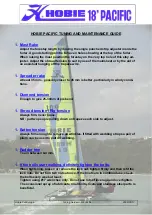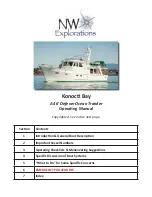
OWNER’S MANUAL
YACHTING SAFETY
32
2
3237 • X6 01/2018
Small Vessels and
Swimmers
Canoes, kayaks, paddle boards and swimming inflatables
have become impulse purchases to many as it looks fun
to do and prices have fallen. Most of these operators
are new to the sport and have no training on rules of the
road or navigation. This is further complicated by the low,
thin profile that makes it difficult to see them, especially in
the sun, glare and rough water. Operators should keep
a close lookout for these vessels, swimmers and other
watercraft. Assume that the person is untrained and give
them plenty of space.
SAFE OPERATION
Boating-related accidents are generally caused by the
operator’s failure to follow basic safety rules or written
precautions. Most accidents can be avoided if you are
completely familiar with your yacht and its operation and
can recognize potentially hazardous situations.
In addition to everyday safety, failure to observe safety
recommendations may result in severe personal
injury or death to you or to others. Use caution and
common sense when operating your yacht. Do not
take unnecessary chances! Failure to adhere to these
warnings may result in severe injury or death to you and/
or others.
Safe operation includes but is not limited to the following:
• Keep the yacht and equipment in safe operating
condition. Inspect the hull, engines, safety
equipment, and all yachting gear regularly. Show all
passengers the location of safety equipment and
explain how to use it.
Federal law requires the owner to provide and maintain
safety equipment onboard. Consult the U.S. Coast Guard,
state, and local regulations to make sure all required
safety equipment is onboard. Additional equipment may
be recommended for your safety and the safety of the
passengers. Become aware of the safety equipment’s
availability and use. Check all safety equipment such as
fire extinguishers, life jackets, flares, distress flags and
flashlights are operable and in good condition.
NOTICE
• Use caution when fueling the yacht. Understand
the fuel tank’s capacity and fuel amount used when
operating at frequently used engine speeds (RPMs).
• Store enough fuel for cruising requirements. Know
the tank’s cruising radius and fuel tank range.
Typical tank usage is 1/3 of the supply to reach
the destination, 1/3 to return, and 1/3 in reserve
for changes in plans due to weather or other
circumstances.
• Always keep fire-extinguishing and lifesaving
equipment onboard. The safety equipment
must meet regulatory standards, and should be
noticeable, accessible, and in proper operating
condition. Passengers onboard should know the
location of the equipment and know how to use
each piece of equipment.
• Keep sea cocks, cockpit drains, hull drain, and other
opening/closing devices in the hull closed or open,
as appropriate, to minimize the risk of flooding.
• Keep an eye on the weather. Be aware of possible
changing conditions by checking local weather
reports before departure. Monitor strong winds and
electrical storms.
• Always keep accurate, updated charts of the chosen
cruising areas. Keep backup charts if using a chart
plotter.
• File a float plan with a family member, relative, friend,
or other responsible person ashore before departure
from port or harbor.
C34_Coupe.indb 32
2/8/2018 3:41:20 PM
Содержание C34 Coupe 2018
Страница 1: ...C34_Coupe indb 1 2 8 2018 3 40 55 PM...
Страница 8: ...OWNER S MANUAL TABLE OF CONTENTS vi 3237 X6 01 2018 NOTES C34_Coupe indb 6 2 8 2018 3 40 59 PM...
Страница 26: ...OWNER S MANUAL GENERAL INFORMATION 18 1 3237 X6 01 2018 NOTES C34_Coupe indb 18 2 8 2018 3 41 08 PM...
Страница 172: ...OWNER S MANUAL MAINTENANCE AND CARE 164 9 3237 X6 02 2018 NOTES C34_Coupe indb 164 2 8 2018 3 44 28 PM...
Страница 180: ...OWNER S MANUAL WINTERIZATION AND STORAGE 172 3237 X6 02 2018 10 C34_Coupe indb 172 2 8 2018 3 44 29 PM...
Страница 182: ...C34_Coupe indb 174 2 8 2018 3 44 30 PM...
Страница 183: ...C34_Coupe indb 1 2 8 2018 3 44 30 PM...
Страница 184: ...C34_Coupe indb 2 2 8 2018 3 44 31 PM...
















































